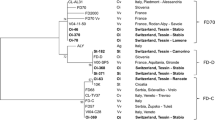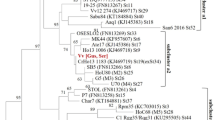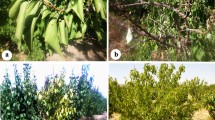Abstract
Intensive surveys were conducted in the main viticultural areas of Turkey in 2009-2010. Two hundred eighty nine symptomatic and 20 non-symptomatic plant samples were collected and subjected to nucleic acid extraction followed by PCR, nested PCR and RFLP analyses to detect phytoplasma presence and for their identification. The incidence rate of phytoplasma infection was 18.33% and the majority of the symptomatic grapevines were infected with grapevine yellows phytoplasmas belonging to 16SrXII-A subgroup (“bois noir”). Phytoplasmas of 16SrV group, aster yellows (16SrI-B) and pigeon pea witches’ broom (16SrIX) groups were also detected in the surveyed vineyards. Phytoplasma-associated infections were present more on wine grapevine cultivars (73.6%), such as Alphonse Lavallée, Alicante Bouschet, Chardonnay, Shiraz, Cabernet Sauvignon, Merlot, Sauvignon Blanc and Pinot Noir, compared to table grapes (26.4%), such as Bogazkere, Sirfani, Tahannebi and Emir.




Similar content being viewed by others
References
Alma, A., Soldi, G., Tedeschi, R., & Marzachì, C. (2002). Role of Hyalesthes obsoletus Signoret in transmission of grapevine Bois Noir in Italy. Petria, 12, 411–412.
Angelini, E., Clair, D., Borgo, M., Bertaccini, A., & Boudon-Padieu, E. (2001). Flavescence dorée in France and Italy-occurence of closely related phytoplasma isolates and their near relationships to Palatinate grapevine yellows and alder phytoplasma. Vitis, 40, 79–86.
Angelini, E. (2010). Field assestment and diagnostic methods for detection of grapevine phytoplasmas. In S. Delrot, H. O. E. Medrano, L. Bavaresco, & S. Grando (Eds.), Methodologies and Results in Grapevine Research (pp. 247–255). New York: Springer.
Avramov, Z., Gillet, J., & Laginova, M. (2008). First detection of stolbur phytoplasma grapevine (Vitis vinifera cv Merlot) affected in Bulgaria. Journal of Phytopathology, 56(2), 112–114.
Bayram, S., Zeybekoglu, U., Soylemezoglu, G., Canik, D., Karavin, M., Cakır, A., & Ertunc, F. (2014). Putative vectors of grapevine yellows phytoplasmas in Turkey. Phytopathogenic Mollicutes, 4(1), 22–26.
Canik, D., Ertunc, F., Paltrinieri, S., Condalto, N., & Bertaccini, A. (2011). Identification of different phytoplasmas infecting grapevine in Turkey. Bulletin of Insectology, 64, 226–227.
Carstens, R., Petersen, Y., Stephan, D., & Burger, J. T. (2012). Incidence of aster yellows disesase in South African vineyards. (pp. 242–243). UC-Davis, CA, USA: Proceedings of the 17th Congress of ICVG.
Constable, F. E. (2010). Phytoplasma Epidemiology: Grapevine as a model. In P. G. Weintraub & P. Jones (Eds.), Phytoplasmas Genomes, Plant Hosts And Vectors (pp. 188–213). London, UK: CABI.
Cvrković, T., Jović, J., Mitrović, M., Krstic, O., & Toševski, I. (2014). Experimental and molecular evidence of Reptalus panzeri as a natural vector of bois noir. Plant Pathology, 63(1), 42–53.
Celik, H., Kunter, B., Soylemezoglu, G., Ergul, A., Celik, H., Karatas, H., Ozdemir, G., & Atak, A. (2010). Bağcılığın Geliştirilmesi Yöntem Ve Üretim Hedefleri, Ziraat Mühendisliği 7. Teknik Kongresi, 23 p, Ankara.
Deng, S., & Huruki, C. (1991). Amplifications of 16S rRNA genes from culturable and non-culturable mollicutes. Microbiological Methods, 14, 53–61.
Duduk, B., Botti, S., Ivanović, M., Krstić, B., Dukić, N., & Bertaccini, A. (2004). Identification of phytoplasmas associated with grapevine yellows in Serbia. Journal of Phytopathology, 152, 575–579.
Duduk, B., Tian, J. B., Contaldo, N., Fan, X. P., Paltrinieri, S., Chen, Q. F., Zhao, Q. F., & Bertaccini, A. (2010). Occurence of phytoplasmas related to stolbur and to ‘Candidatus Phytoplasma japonicum’ in woody host plants in China. Journal of Phytopathology, 158, 100–110.
Gthb, T. C. (2012). Gıda, Tarım ve Hayvancılık Bakanlığı, Bitki Karantinası Yönetmeliği, 55 p.
Gibbs, K. S., Padovan, A. C., & Mogen, B. A. (1995). Studies on sweet potato little-leaf phytoplasmas detected in sweet potato and other species growing in Northern Australia. Phytopathology, 85, 169–174.
Güçlü, S., & Özbek, H. (1988). Some studies on the biology of Hyalesthes obsoletus Signoret (Homoptera: Cixiidae) in the conditions of Erzurum. Türkiye Entomology Dergisi, 12, 103–111.
Gundersen, D. E., & Lee, I.-M. (1996). Ultrasensitive detection of phytoplasmas by nested PCR assays using two universal primer pairs. Phytopathologia Mediterranea, 35, 144–151.
Hall, T. A. (1999). BioEdit: a user-friendly biological sequence alignment editor and analysis program for Windows 95/98/NT. Nucleic Acids Symposium Series, 41, 95–98.
Karimi, M., Contaldo, N., Mahmodi, B., Duduk, B., & Bertaccini, A. (2009). Identification of stolbur related phytoplasma in grapevine showing decline symptoms in Iran. Le Progrès agricole et viticole, HS, 208-209.
Kuzmanovic, S., Martini, M., Ermacora, P., Ferrini, F., Starovic, M., Tosic, M., Carraro, L., & Osler, R. (2008). Incidence and molecular characterization of Flavescence dorée in grapevine cultivars in different viticultural areas in Serbia. Vitis, 47, 105–111.
Lee, I.-M., Gundersen, D. E., Hammond, R. W., & Davis, R. E. (1994). Use of mycoplasma like organism (MLO) group-specific oligonucleotide primers for nested PCR assays to detect mixed–MLO infections in a single host plants. Phytopathology, 84, 559–566.
Lee, I.-M., Davis, R. E., Gundersen-Rindal, D. E., Davis, R. E., & Bartoszyk, I. (1998). Revised classification scheme of phytoplasmas based on RFLP analyses of 16 Sr RNA and ribosomal protein gene sequences. International Journal of Systematic Bacteriology, 48, 1153–1169.
Lessio, F., & Alma, A. (2004). Dispersal patterns and chromatic response of Scaphoideus titanus Ball (Homoptera, Cicadellidae), vector of the phytoplasma agent of grapevine flavescence dorée. Agricultural and Forest Entomology, 6, 121–127.
Maixner, M. (1994). Transmission of German grapevine yellows (Vergilbungskrankheit) by the planthopper Hyalesthes obsoletus (Auchenorrhyncha: Cixiidae). Vitis, 33, 103–104.
Maixner, M. (2011). Recent advances in Bois Noir research. Petria, 21(2/3), 17–32.
Martini, M., Murari, E., Mori, N., & Bertaccini, A. (1999). Identification and epidemic distribution of two flavescence dorée related phytoplasmas in Veneto (Italy). Plant Disease, 83, 925–930.
Martini, M., Botti, S., Marcone, C., Marzachi, C., Casati, P., Bianco, P. A., Benedetti, R., & Bertaccini, A. (2002). Genetic variability among flavescence dorée phytoplasmas from different origins in Italy and France. Molecular Cellular Probes, 16, 197–208.
Prince, J. P., Davis, R. E., Wolf, T. K., Lee, I.-M., Mogen, B. D., Dally, E. L., Bertaccini, A., Credi, R., & Barba, M. (1993). Molecular detection of diverse mycoplasmalike organisms associated with grapevine yellows and their classification with aster yellows, x-disease and elm yellows MLOs. Phytopathology, 83, 1130–1137.
Quaglino, F., Zhao, Y., Casati, P., Bulgari, D., Bianco, P. A., Wei, W., & Davis, R. E. (2013). ‘Candidatus Phytoplasma solani’ a novel taxon associated with stolbur and bois-noir- related diseases of plants. International Journal of Systematic Evolutionary Microbiology, 63(8), 2879–2894.
Sabaté, J., Lavina, A., Legorburu, J., Fortanete, J., Perez De Obanos, J. J., Perez Marin, J. L., Reyes, J., & Batlle, A. (2007). Incidence of “Bois Noir” phytoplasma in different wine-growing regions of Spain and its relation to Hyalesthes obsoletus. Bulletin of Insectology, 60(2), 367–368.
Schneider, B., Seemüller, E., Smart, C. D., & Kirkpatrick, B. C. (1995). Phylogenetic classification of plant pathogenic mycoplasmalike organisms or phytoplasmas. In S. Razin & J. G. Tully (Eds.), Molecular and Diagnostic Procedures in Mycoplasmology (pp. 369–380). New York: Academic Press.
Schvester, D., Carle, P., & Moutous, G. (1961). Sur la transmission dela flavescence dorée des vignes par une cicadelle. Comptes Rendus des Séances de l’Académie d’Agriculture de France, 47, 1021–1024.
Seemüller, E., Marcone, C., Lauer, U., Ragozzino, A., & Goschl, M. (1998). Current status of molecular classification of the phytoplasmas. Journal of Plant Pathology, 80, 3–26.
Sforza, R., Clair, D., Daire, X., Larrue, J., & Boudon-Padieu, E. (1998). The role of Hyalesthes obsoletus (Hemiptera: Cixiidae) in the occurrence of bois noir of grapevines in France. Journal of Phytopathology, 146, 549–556.
Thompson, J. D., Gibson, T. J., Plewniak, F., Jeanmougin, F., & Higgins, D. G. (1997). The CLUSTAL X windows interface: flexible strategies for multiple sequence alignment aided by quality analysis tools. Nucleic Acids Research, 25, 4876–4882.
Tuik. (2008). Tarımsal Yapı Ve Üretim. Ankara: Başbakanlık Devlet İstatistik Enstitüsü yayınları.
Weintraub, P. G., & Beandland, L. (2006). Insect vectors of phytoplasmas. Annual Review of Entomology, 51, 91–111.
Weintraub, P. G., & Jones, P. (2010). Phytoplasmas, Genomes, Plant Hosts And Vectors. United Kingdom: Cab International.
Acknowledgments
The authors are grateful to Turkish Scientific and Technological Research Council for supporting this research by Project coded COST-109O005 and also to COST Action FA0807 for founding COST-STSM-090110. Part of the work was carried out in the frame of the COST Action FA0807 ”Integrated managemant of Phytoplasma Epidemics in Different Crop Systems” at Bologna University.
Author information
Authors and Affiliations
Corresponding author
Rights and permissions
About this article
Cite this article
Ertunc, F., Orel, D.C., Bayram, S. et al. Occurrence and identification of grapevine phytoplasmas in main viticultural regions of Turkey. Phytoparasitica 43, 303–310 (2015). https://doi.org/10.1007/s12600-014-0449-7
Received:
Accepted:
Published:
Issue Date:
DOI: https://doi.org/10.1007/s12600-014-0449-7




